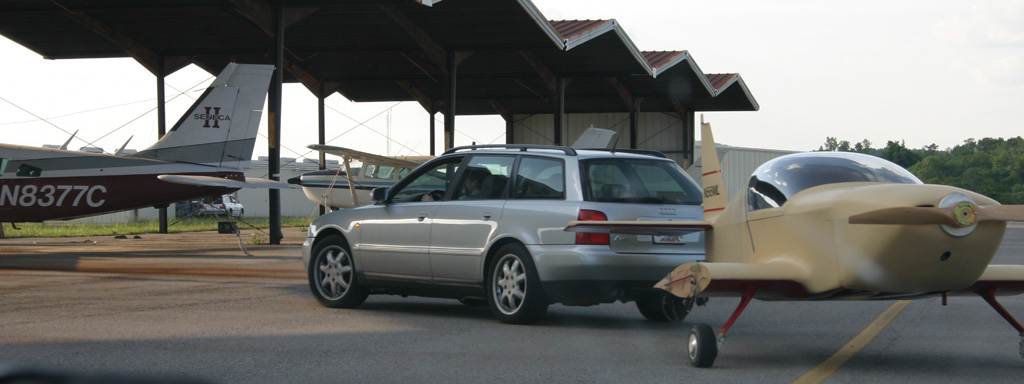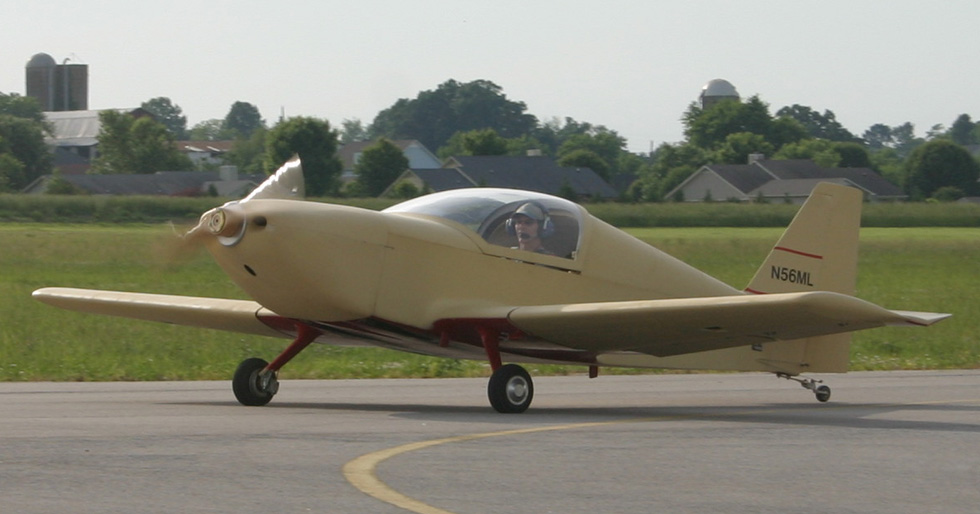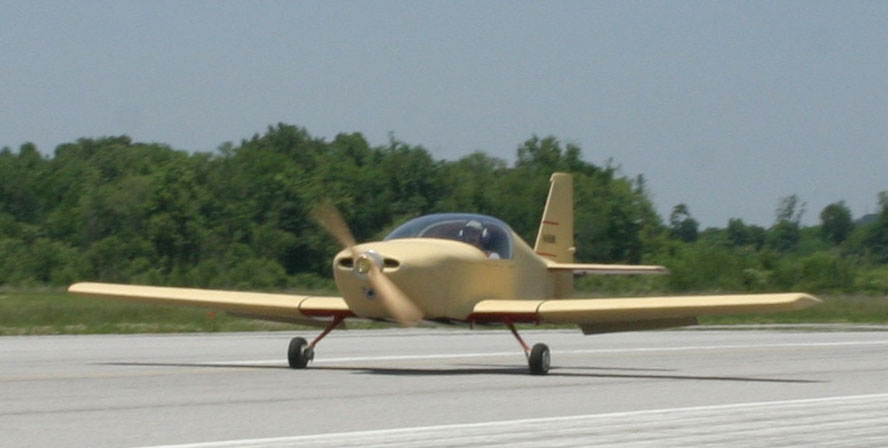First Flight of Mark Langford's KR2S
N56ML's First Flight
created May 19, 2005

Well, after 5300 hours spread over 12 years, and still far from completion (the yellow stuff is urethane primer, not paint), N56ML flew for the first time today. Troy Petteway had volunteered to fly it years ago, and it made perfect sense to let him do it, since he's a Citation pilot by day, and a high-time taildragger and KR pilot, and can fly with his eyes closed, hands tied behind his back, and one wing missing. He's the builder and pilot of KR2 N100TP, which I believe to be the fastest KR on the planet.
He flew down this morning along with his Citation co-pilot Mike and also his buddy Trevor (Corvair powered Cassutt builder), and proceeded to check my airplane over for the maiden voyage. They found a missing pin and a nut missing, and we safety wired one side of two turnbuckles that couldn't be clipped. They hadn't loosened during taxi testing, but it only made sense to make sure they couldn't. He looked everything in the control department over well, and we decided to ditch the elevator counterweight completely (it's a little flimsy side to side) so we just unbolted the lead weight for now. His plane has no counterweights on the elevator at all, and he routinely does 230 mph or more with no problems. He also reminded me that at one time he had aerodynamic balances, but cut them off because they made the plane more pitch sensitive. Now there's a data point for ya! We also found a screwdriver laying back there that I'd left there yesterday, so I had to retrieve it by unzipping the rear deck again. There's a lot to be said for letting somebody (or two or three people) go through it after you think it's ready to go, because if you're like me, you're just kiddin' yourself when you've convinced yourself that you checked them all. I have to give Troy a lot of credit for crawling into a plane that looked like it was duct taped together, with pathetic excuses for why this didn't work, and that isn't quite right!
I had yet to see the airspeed indicator get off the peg, even up to over 60 mph (according to the GPS), but the day before I'd put Loctite thread sealant on every connection, so I thought maybe I'd fixed it. Today we tested the pitot system and it held pressure, so we thought we were good to go there, but I left the GPS on the seat, turned on, just in case. I also plugged in the laptop to gather data from the Engine Information System and left it in the passenger's seat.

(Photo by WonderWife Jeanie)
We talked about the flight plan and I agreed to read it out from the ground with a handheld while he flew, so he wouldn't have to worry about reading it or writing anything down. He said he'd make a few taxi runs so off he went and I went by the FBO to alert them to be ready in case something happened. When I walked out the door I heard him throttle up and he took off! He said it was getting so hot in there (no real cabin ventilation yet) he figured he'd just get it in the air and cool off. The EIS later told me it was 104 degrees in there! He climbed out and circled the airport at 3000' or so about three times...just long enough to let the engine temps stabilize to get a feel for it. The ASI showed signs of life up to takeoff, but then started getting flaky, and the VSI was indicating a constant descent, so it looks like there's either something wrong with my static tube location or the way I plumbed it. That'll be my first thing to fix, but it shouldn't be a big deal.
Other than the ASI/VSI problem and no ventilation, his only real squawks were that it needed some rudder trim, and aileron trim because the right side was heavy, and the cabin needed some ventilation of some kind. The rudder trim's not surprising considering there is no vertical stab or engine mount offset to counter the p-factor, and I think the left aileron trim is due to the flap on the left side hanging down a little. I really never got around to adjusting it flush to the wing, mainly because I need to grind a 7/16" wrench down to about an eighth inch thick, or make one out of some aluminum. Whatever it takes, I'll fix them both, but I'll probably fix the trim internally with a spring on the right rudder pedal like Troy has. He also didn't like how stiff the throttle is, so I'll cut some coils off the spring that resists the push button on the knob to make the button easier to push. I also have a vernier throttle that I may re-install. I had it installed before, but took it out because it was so big and looked out of place.

In the "good news" department, he said it was "rock solid" and very stable in all three axes. He also commented on how good the ground handling was compared to his, and that just about any idiot could handle it on the ground (that explains why I do so well in it). Some of that is due to the longer length and taller vertical stabilizer and rudder on the KR2S, but some is probably due to the wider than normal stance of the gear. He did most of his flying at about 2400 rpm, deliberately trying to keep it slow since the mission of the first flight is to feel it out and get back in one piece, rather than find out how fast it will go. He was very impressed with the smoothness of the Corvair, and said it pushed him back in the seat when he firewalled it! 120 mph is about as fast as he went, throttling back to 2400 rpm or so, because this was a first flight...not the time to see if the canopy was going to fly off or the ailerons were going to flutter at 200 mph.

Here's the plot of the EIS data. For some reason all of the thermocouples (both CHT and EGT) have a jitter to them. I'll talk to EIS about that. The two places where the rpm dropped to zero are where he switched from one ignition system to the other. Right now the tach is only connected to one of them. The oil temperature never exceeded 160 degrees, despite the 80 degree ambient temperature, but they were still steadily climbing. Still, I have a long way to go, and more testing will let me know if I have enough oil cooler or enough ducting to the cooler, which is just a 2" SCAT line for now. CHTs never exceeded 320 degrees, most stayed below 300, they were very close together, and they had stabilized. And that's without a spinner! There is no discernible difference between the temperatures of the left bank and left bank, so the plenums are working great. Good enough for me!
In other news, Troy never touched the mixture but the engine ran great, and he also left the ram air open. He said the trim never got more than one LED away from neutral, which is only a few degrees on a trim tab that's half the size the plans call for. Further testing at higher speeds will tell, but for right now he thinks the horizontal stabilizer incidence is perfect (it's set to -75 degrees to go along with the reduced wing incidence). He did not test the flaps, as that's something I'd rather slowly sneak up on after I've mastered landing the thing, or at least tested at altitude first.
Troy had to rush off to fly the Citation somewhere, but gave me a quick lesson on how to transition from flight to ground when I fly it. Take off with the tail slightly up, memorize the picture, and when you come back to land get that same attitude until you touch down. I plan to straighten out the pitot/static system, try to add some cabin air ventilation, hit some of the other little squawks, and fly it Sunday morning about 8:30 or 9:00 at MDQ. I'll let you know how it goes. This plane is obviously nowhere near finished. There's a lot of work yet to be done on it, and the testing and improvement phase begins NOW!
Thanks a million to Troy for flight testing N56ML for me. Now when I fly it, I don't have to crawl in there wondering if it's going to quit on takeoff, or fly to pieces. All I have to think about now is learning that missing little part about transitioning from flight to ground regime. I'll bet I can do that too...
Earlier... May 15th, 2005
I've taken the last two weeks off to do nothing but work on the plane, and if I have my way, I'll take this week off and maybe fly it before the week's out. In the last 14 days I've put 172 hours into the plane. I spent most of today wiring up the limit switch and DPDT switch for my flap motor. You ain't seen nothin' 'til you've seen 30 degrees of barndoor flaps on a KR! It takes four seconds to go from zero to 30 degrees using an RV flap motor. That ought to be fast enough.

Most normal people would put the thing on a trailer, but being a lazy scud, I just removed the tailwheel and replaced it with the hitch from my Harbor Freight trailer. It took all of 2 minutes to hitch the KR to the Audi and haul it away on its main gear, although I'll admit that I never got over 35 mph on the 10 mile drive to the airport. Jeanie followed me in my GTI with the flashers going. After we got the plane there, we came back and stuffed a wing in the back of each car, took them to the airport, and installed them. She helped me get the wings installed, and afterward gave me a big hug and said something like "welcome to your dream".
These are "plane ports", the only thing available at MDQ right now. I'm starting out there because they have a 100' wide 5000 foot runway surrounded by fields, as opposed to Hazel Green (M38), which has a 40' wide runway that's only 2700' long (although that's where I'll keep it after I get skilled enough to get it in there).

The next day I had the ailerons and flaps rigged an was taxi testing. At first I ran all over the place, and was happy that I had a 100' wide runway, and was wondering why I'd built a taildragger instead of a tricycle gear plane.

Then... May 17th, 2005
Keep in mind that as of sunset yesterday, I felt ready to fly my plane. After some advice from KRnetters, I was taxiing like a pro, feeling like I had really mastered ground handling on the thing. So this morning I went out to get some MORE practice, and had 20 high speed runs in before the FBO opened at 8AM. I guess I'm crazy, but I was giving it full throttle, tail came up in 20-30 feet, then I'd back off to maybe 2000 rpm for a few seconds, and then to idle and coast tail up most of the way down the runway, with the goal of dropping the tail with a thousand feet of runway left so I wouldn't need to touch the brakes at the end. If it looked like I was a little short of making the 1000' marker, I'd add a little power to get me there. Whoever came up with that one was right on the mark. It's just like a takeoff, and just like a landing, one each for every run, and a little fun in between. I am tracking the centerline pretty well, and have gotten to the point of thinking "is that all ya got? That's all there is to it?". These are probably famous last words, but I feel like I have complete control over the airplane on the ground, but I also have more than 75 taxi runs under my belt, so that shouldn't be a surprise. It's kind of funny...late Monday I was thinking "I shoulda built a tri-gear", but today I'm thinking "this taildragger has made me a better pilot". Of course the winds have been fairly calm too, and I should probably find some wood to knock on.
One thing I can say already about those big flaps is that regardless of whether or not they do anything in the air, they add at least 2000' to this 5000' runway. It makes a huge difference in ground roll with them down. If I start thinking I'm too close to the end, I'll drop them and it really starts slowing down, and it's amazing how much slower I can go with the tail up with the flaps down. It's kind of cool how I can just let it coast and keep moving the stick further and further foward til I hit the stop, and then the tail slowly drops. This happens at maybe 20-25 mph, so it's entirely controllable. The tail dropping happens closer to 35 mph with no flaps. I could ground loop the thing at that speed and just laugh about it! Funny thing is that I haven't come anywhere close to a ground loop so far.
The neat thing about going out early (or staying late) is that I could "back taxi" doing the same routine, and there was nobody around to care. Bottom line is it takes maybe a minute and a half to do a run, and then do a U-turn and make another one. I announced them all on the radio though, so there would be no surprises, unless that Champ that Rick Stroud taught me taildraggin' in comes around...since it has no radio. Thanks again, Rick!
Details of MY first flight were not as good as Troy's, but certainly entertaining, so check 'em out...
Contact Mark Langford (if you must) at N56ML "at" hiwaay.net (replace the "at" with @)
Return to Mark Langford's KR2S N56ML.






